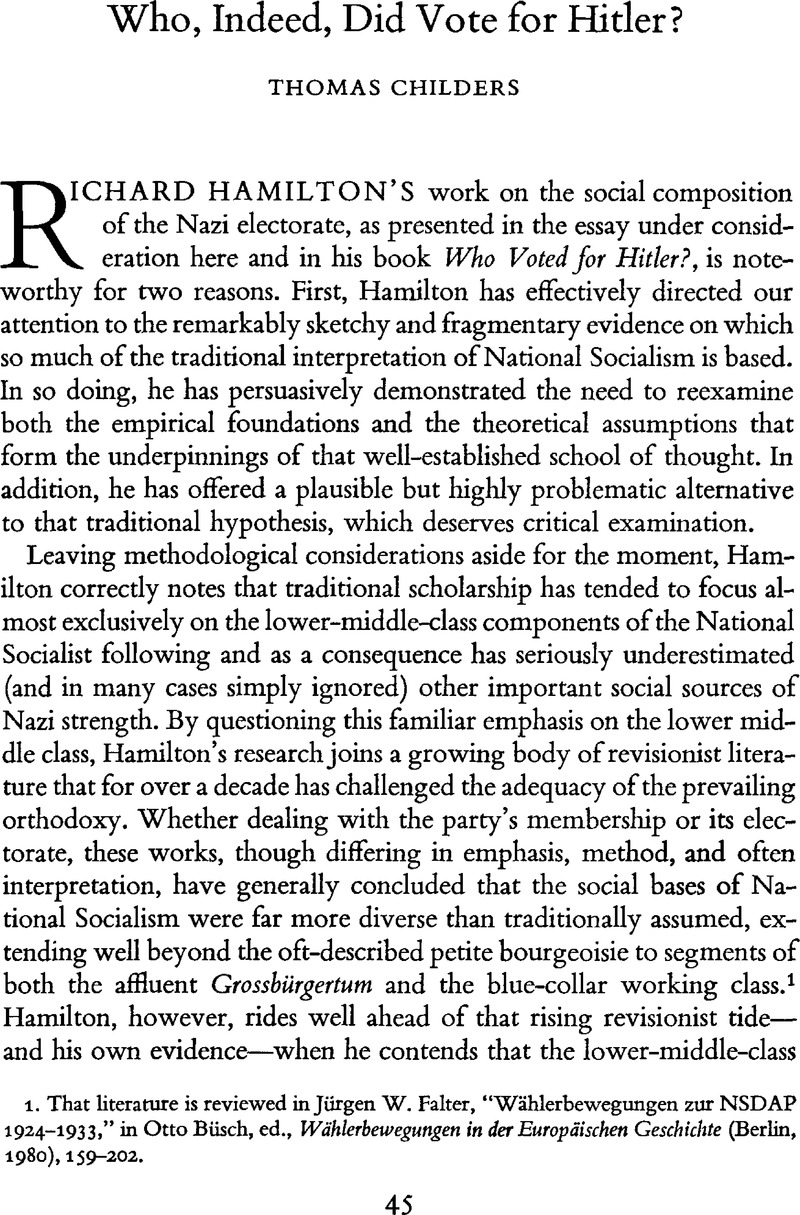Published online by Cambridge University Press: 16 December 2008

1. That literature is reviewed in Falter, Jürgen W., “Wählerbewegungen zur NSDAP 1924–1933,” in Büsch, Otto, ed., Wählerbewegungen in der Europäischen Geschichte (Berlin, 1980), 159–202.Google Scholar
2. This conclusion is the result of a systematic evaluation of the massive collections of Weimar campaign literature found in the Bundesarchiv Koblenz, the Geheimes Staats-archiv Preussischer Kulturbesitz Berlin, the Zentrales Staatsarchiv Potsdam, the Bayeri-sches Hauptstaatsarchiv Munich, the Landesarchiv Berlin, the Hoover Institution Archives (Weimar Republic Collection), and the NSDAP Hauptarchiv.
3. The organization and tactics of National Socialist campaigning, especially the party's emphasis on such leaflet literature, emerge clearly from the files of the NSDAP Hauptarchiv, esp. reels 14–15, 29–30, and 58.
4. Aside from the now standard works of Allen, William S., The Nazi Seizure of Power (Chicago, 1965)Google Scholar and Noakes, Jeremy, The Nazi Party in Lower Saxony 1921–1933 (Oxford, 1971)Google Scholar, a number of case studies do examine local electoral politics in the fashion suggested above. Among the most useful are: Zofka, Zdenek, Die Ausbreitung des Nationalsozialismus auf dem Lande (Munich, 1979)Google Scholar; Ciolet-Kumper, Jutta, Wahlkampf in Lippe: Die Wahlkampfpropaganda der NSDAP zur Landtagswahl am 15. Januar 1933 (Munich, 1977)Google Scholar; Mann, Rosemarie, “Entstehung und Entwicklung der NSDAP in Marburg bis 1933,” Hessisches Jahrbuch für Landesgeschichte 22 (1972): 254–342.Google Scholar
5. Hamilton, Richard, Who Voted for Hitler? (Princeton, 1982), 83, 112.Google Scholar
6. The literature on regression analysis and its applicability to ecological data is massive. The best explanations are found in Kousser, J. Morgan, “Ecological Regression and the Analysis of Past Politics,” Journal of Interdisciplinary History 4 (1973): 237–62CrossRefGoogle Scholar; and Lichtman, Allan J., “Correlation, Regression, and the Ecological Fallacy: A Critique,” in the same journal, 4 (1974): 417–34.Google Scholar
7. Although Braunschweig is, indeed, smaller than the other cities in Hamilton's original sample, it was clearly counted among Germany's major metropolitan areas in 1932. With a population in excess of 100,000 inhabitants, it was, along with approximately fifty other major cities, officially classified as a Grossstadt. Roughly 70 percent of Germany's population lived in smaller towns and cities, a striking 44 percent residing in towns and villages with fewer than 5,000 inhabitants. Thus, even with the inclusion of Braunschweig, Hamilton's sample still reflects a strong urban, big-city bias. On the distribution of the population among the Gemeindegrössenklassen, see the Statistisches Jahrbuch für das Deutsche Reich, 1934, 11.
8. Kater, Michael H., The Nazi Party: A Social Profile of Members and Leaders, 1919–1945 (Cambridge, Mass., 1983), 19–71, 234–39Google Scholar; and Childers, Thomas, The Nazi Voter: The Social Foundations of Fascism in Germany, 1919–1933 (Chapel Hill and London, 1983), 262–69.Google Scholar
9. Childers, The Nazi Voter, 264, 280.
10. See Winkler, Heinrich August, Mittelstand, Demokratie und Nationalsozialismus: Die politische Entwicklung von Handwerk und Kleinhandel in der Weimarer Republik (Cologne, 1972).Google Scholar
11. Childers, The Nazi Voter, 64–80, 142–59, 211–24.
12. The importance of these local networks is compellingly argued in Koshar, Rudy, “Organizational Life and Nazism: A Study of Mobilization in Marburg an der Lahn 1918–1935” (Ph.D. diss., Univ. of Michigan, 1979).Google Scholar
13. Those materials are located in the NSDAP Hauptarchiv and in National Archives, Washington, esp. T-81.